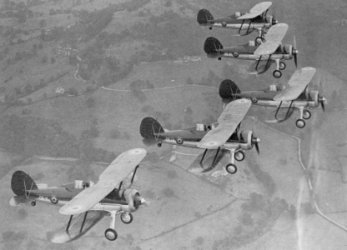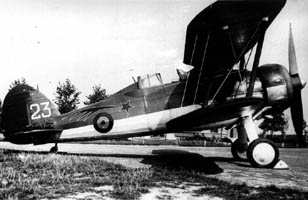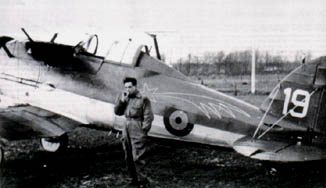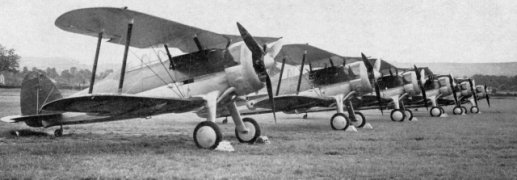

Carrying SBAC registrations, these five Belgian Gladiators are seen during their delivery flight.
Early aircraft had Watts propellers.


Carrying SBAC registrations, these five Belgian Gladiators are seen during their delivery flight.
Early aircraft had Watts propellers.
Belgium had ordered 22 Gladiator Is during the summer of 1937, and although delivery of these commenced in September that year, final signature of the contract was not effected until May1938. The delay was caused by negotiations (which were abandoned) for the licence production of the Gladiator by the Belgian aircraft industry. The Belgian Gladiators were introduced into service with the 1ère Escardrille de Chasse ("La Comète") in the Ième Group of No.2 (Fighter) Regiment based at Diest, and of these aircraft 15 remained on strength until 10 May 1940.

On 9 December 1939, Gladiator G.28 of 1/I/2 dived vertically into the ground and was destroyed at Ingelmuster, due to malfunctioning oxygen supply. The pilot Sergent H. Dopagne was killed.
On 11 March 1940, Gladiator G.21 of 1/I/2 crashed of unknown cause at Steene-Ostend airfield. The pilot Sergent Pipart was killed.
Gladiator G.35 of 1/I/2 crashed of unknown cause into the sea on 19 April. The pilot was saved but the aircraft was lost.
In the early morning of 10 May, the alert was sounded just before 03:00 at Shaffen-Diest airfield. Major Hendrickx, commander of the 1st Group, 2nd Regiment, ordered the aircraft to remain lined up along the runway. Besides the Hurricanes of Escadrille 2/I/2 (the most modem aircraft in the Belgian Military Air Arm) and the Gloster Gladiator of Escadrille 1/I/2, the base was host to the Fairey Fox biplanes of Escadrille 5/III/3 and 7/III/3. The Foxes were to take part in live firing exercises at Beverloo.
Eleven of the twelve serviceable Hurricanes were facing the hangars, the twelfth, (H.41) was standing some way apart from the rest. The pilots believed that the alert is part of an exercise and got ready to fly to the grass airfield at Beauvechain to carry out a routine patrol over the Ardennes.
On the other side of the airbase, the pilots of 1/I/2 Aé climbed into the cockpits of their Gladiators and run their engines briefly. The fourteen biplanes were also lined up wingtip-to-wingtip, making a continuous line with the Hurricanes. The order to take off was not issued because of a dense fog that covered the region.
At 04:20hrs, the Fairey Foxes of 5/III/2 Aé took off and headed towards Landing Field No. 14 (Jeneffe) to reconnoitre German troop movements east of Liege. They were diverted in mid-flight to Landing Field No. 23 at Vissenacken.
A few moments later, around fifty unidentified aircraft flew over Schaffen. Acting on his own initiative Capitaine Max Guisgand, commander of 1/I/2 led his Gladiators into the air despite the contrary order, issued by his group commander, to stay put. While the Hurricanes started up their engines, the two leading sections of Gladiators were airborne at 04:20.
At 04:32hrs, three hedgehopping Do 17s from KG 77 suddenly appeared. Untroubled by the anti-aircraft fire, which was totally ineffective, the Dorniers took all the time they needed to shoot up the airfield while the Gladiators tried to take off surrounded by explosions and fires. In the prevailing panic, after a bullet punctured a main wheel on his Gladiator, Lieutenant M. Wilmots rammed the Hurricane H-20 flown by Capitaine Charlier of 2/I/2. Wilmot suffered shrapnel wound in his leg and the Gladiator was a write-off. Capitaine Charlier was wounded.
Within minutes, Bf 110s and Dornier Do 17s arrived over Schaffen. The first strafed the airfield while the second bombed it. Four Hurricanes were set on fire and six others received varying degrees of damage. The machines under cover were flattened when half of the hangar roof fell in. Wilmots' Gladiator was destroyed on the ground. Sergent Libert was severely burnt when the fuel tank of his Hurricane H-24 exploded. A Second gladiator of 1/I/2 was caught on the ground in the low-level attack of the Dorniers and was destroyed.
Two Hurricanes, flown by Capitaine Van den Hove d`Ertsenrijck and Caporal Jacobs, managed to escape from Schaffen. As they head for Beauvechain, they encountered a pack of enemy bombers. Van den Hove attacked one - apparently without success - even though a Gladiator pilot, Sergent Van den Broek, helped him. The oil tank of Van Broek's machine was hit in an exchange of fire, forcing him to make a crash landing in open country. A third Hurricane (H-27), waiting for a propeller at Schaffen was made airworthy and evacuated to Beauvechain by Sergent Siroux. On arrival, the main spar of one the wings, was found to be damaged, rendering the aircraft unfit for combat.
The third section of Gladiators from 1/I/2 Aé, which took off at 04:32, found themselves almost nose to nose with the three Do 17s, which forced two of them to break away to avoid a mid-air collision. The second section (Capitaine Gérard (G.27), 1er Sergent Henry Winand (G.32) and Sergent Henri Clinquart (G.34), en route for Beauvechain, spotted a formation of enemy bombers over Tirlemont and broke it up.
In the lull after the bombing, other Gladiators left Schaffen. Hurricane pilots (Siroux, Lelarge and the confusingly named Lieutenant) flew three of them. In all, twelve Gladiators arrived at Beauvechain. As the ultimate reinforcement Gladiator G.18 - the personal aircraft of Général Hiernaux, C-in-C of l'Aviation Militaire - was placed at the disposition of 1/I/2. Unfortunately, the aircraft was not fitted with guns...
Of the proud 1er Groupe de Chasse, the elite Belgian fighter unit, only two Hurricanes and twelve Gladiators were still airworthy and able to fight after the morning attacks.
Several aerial encounters were reported between Gladiators and German fighters on 10 May. As a matter of record, Belgian Gladiators were never engaged with Bf 109s during this day. The engagements reported by German pilots are probably due to mistaken identification by them, an excusable mistake, given the number of different types of biplanes serving with the different European air forces at this time. Luftwaffe pilots claimed five Gladiators during the day and reported engagements were:
At 09:55, ten Bf 109s from 3./JG 27 run into Gladiators over Tirlemont. Leutnant Erwin Axthelm and Unteroffizier Heinrich Belcher claimed two. One Belgian pilot baled out and deployed his parachute.
At 10:33, three more Gladiators were claimed by Oberleunant Georg Schneider (victory no. 3), Leutnant Hans-Ekkehard Bob (victory no. 1 of a total of 60) and Feldwebel Leykauf (victory no. 1 of a total of 33) from 3./JG 21 (as 9./JG 54) over Tongeren when their unit's Bf 109s were escorting a gaggle of Ju 87s to the west of Maastricht.
Shortly before 07.00 on 11 May, nine Belgian Fairey Battles of 5/III/3 Aé were dispatched to bomb the Albert Canal bridges, which had fallen intact into German hands. Six Gladiators of 1/I/2 Aé were to escort them. The Gladiators flew in two sections. The first section was led by the Commandant Capitaine Max Guisgand (Gloster G.27) and included Sergent André Pirlot (Gloster G.19) and Sergent A. Vanden Broeck (Gloster G.31). The second section took off 10 minutes later and was led by 1er Sergent Denys Rolin (Gloster G.22) and included 1er Sergent Henry Winand (Gloster G.32) and Sergent Henri Clinquart (Gloster G.34).
When they arrived to their assigned sector, they became involved in a dogfight with eight to twelve German Bf 109s from I/JG1. During this dogfight 1er Sergent Winand claimed a damaged Bf 109 and 1er Sergent Rolin was credited with one Bf 109 probable damaged. He didn't see if his victim dived away or crashed because right after this he was shot down and taken prisoner. The only known losses suffered by I/JG 1 on 11 May was a plane of 3./JG 1, which ran out of fuel and made a forced landing near Achen and was 70% destroyed.
During the dogfight five German pilots (all from 1./JG 1) claimed seven victories in the Maastricht area:
- Leutnant Günter-Erwin Mann (06.50 h) (possibly Capitaine Max Guisgand (Gloster G.27))
- Leutnant Ludwig Franzisket (06.53 h) (victory 1 of totally 43) (possibly Sergent Henri Clinquart (Gloster G.34))
- Staffelkapitän Hauptmann Wilhelm Balthasar (06.55, 06.58 and one more during the same mission) (victory 1-3 of totally 47) (possibly 1er Sergent Denys Rolin (Gloster G.22) and Sergent André Pirlot (Gloster G.19))
- Unteroffizier Heinz Gillert (07.01 h) (possibly Sergent A. Vanden Broeck (Gloster G.31)).
- Unteroffizier Emil Clade (07.01 h) (possibly 1er Sergent Henry Winand (Gloster G.32))
Only four Gladiators of 1/I/2. Aé were however lost:
- Sergent André Pirlot (MIA) was shot down in flames in Gloster G.19.
- 1er Sergent Denys Rolin (POW) was shot down but saved himself in parachute but was taken prisoner. His aircraft (G.22) was abandoned over Heukelom at 05:55).
- Sergent Henri Clinquart (KIA) was shot down in flames. His aircraft (G.34) crashed between Flexhe and Slins, north of Liege.
- Capitaine Max Guisgand made a forced landing in a field at Faimes close to Waremme after that his Gloster (G.27) had been damaged by enemy fire and he was wounded in the face. The aircraft was later burned.
Sergent A. Vanden Broeck (Gloster G.31) and 1er Sergent Henry Winand (Gloster G.32) returned to Beauvechain with badly damaged aircraft. Both pilots were unhurt and both aircraft were repairable.
The attack on the bridges by the Battles was a failure and six of them were lost.
In the early afternoon between 14:07 and 14:32 Messerschmitts from I./JG 1 destroyed seven Belgian Gladiators and three Belgian Hurricanes on the ground at Beauvechain. A second attack between 16:30 and 17:00 by He 111s destroyed one more Gladiator and two Hurricanes. During the attack, an English Lysander flew over the airfield but managed to escape roving German aircraft. A Blenheim wasn't so fortune and it was shot down with the crew parachuting. During the two attacks, the airfield defence was very weak. At least Glosters G.31, G.32 and G.38 was damaged. Totally 11 Gladiators were destroyed or damaged but there were no pilot casualties. All aircraft were write-offs or abandoned on withdrawal to Belsele that night.

No more combats with Belgian Gladiators are known even if many Luftwaffe records refer to "enemy biplane fighters" there is nothing to indicate whether they were Belgian or British Gladiators or Belgian Fiat CR.42s.

Sources:
Air Force on the Edge - Dionisio Garcia, 2001, Air Enthusiast November/December 2001
Désastre à Schaffen - Christian-Jacques Ehrengardt, 2000, Aéro Journal No. 12
Escadrilles Au Combat - Jean Delaet kindly provided by Luc Faucon
Luftwaffe Claims Lists - Tony Wood
The Battle of France Then and Now – Peter D. Cornwell, 2008 After the Battle, ISBN 9-781870-067652
The Gloster Gladiator - Francis K. Mason, 1964
Twelve Days In May - Brian Cull and Bruce Lander with Heinrich Weiss, 1999, Grub Street, London, ISBN 1-902304-12-8
Much information kindly provided by Peter Taghon and Michel Terlinden

